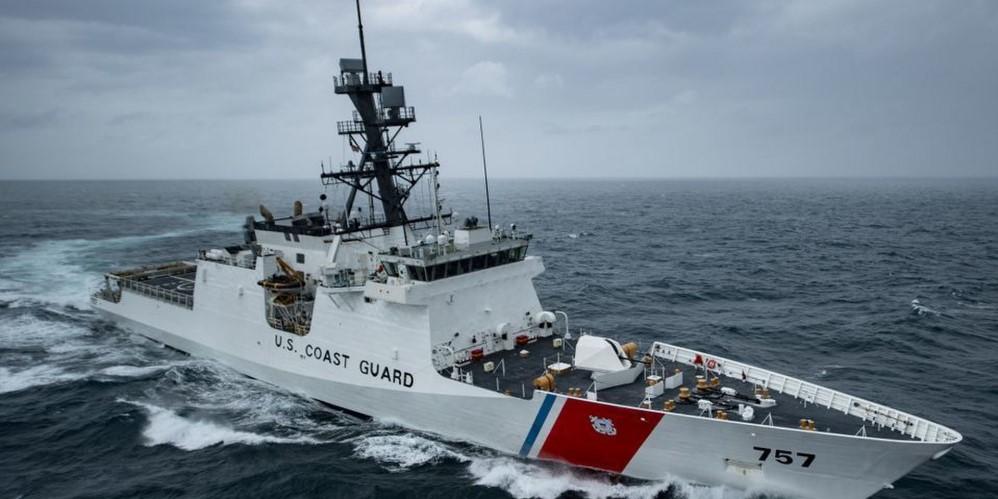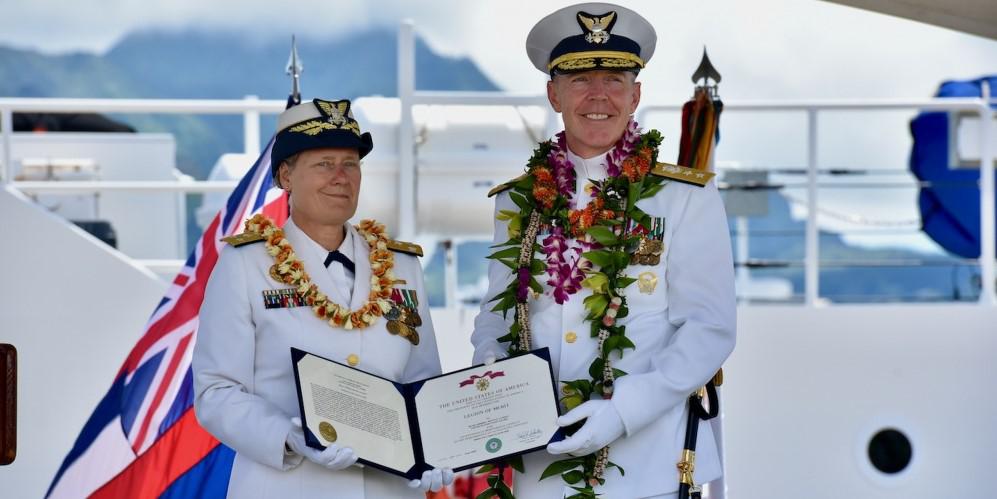U.S. Coast Guard Adds Assets to Indo-Pacific Region
The seas of the Indo-Pacific region are an increasingly complex maritime environment. To combat an increase in nefarious activity, protect U.S. economic security and thwart brazen adversaries, the U.S. Coast Guard is adding resources to its operations there, says Vice Adm. Linda Fagan, USCG, commander, U.S. Coast Guard Defense Force West and commander, Pacific Area, presented a keynote address Thursday at AFCEA’s TechNet Indo-Pacific conference.
“To achieve our national security goals in the Indo-Pacific, we have increased our operational capacity and capability in the region,” the vice admiral confirmed. “One of my top priorities has been to execute the commandant’s direction to utilize Coast Guard authorities and leverage the capability of our newest and largest ship asset, the national security cutters in a way that counters threats to regional stability, helps ensure free trade, and sovereignty in the nations of Oceania and the Indo-Pacific.”
The @USCG sits between the lethality of @DeptofDefense and the diplomacy of the @StateDept - VADM Fagan @USCG #AFCEATechNet pic.twitter.com/R3MO6qxyZr
— Kimberly Underwood (@Kunderwood_SGNL) March 3, 2021
In the region, the service is facing a space that is “increasingly competitive” with “unprecedented periods of manmade environmental threats,” the commander emphasized. The Indo-Pacific is vulnerable to narcotics trafficking, human smuggling, illegal fishing, piracy and terrorist activities.
To perform its duties, the guard will keep adding to its cadre of national security cutter ships. In 2019, the service commissioned two more cutters into the AOR, the USCGC Kimball and the USCGC Midgett—the service’s seventh and eighth cutters, which are homeported in Honolulu. “And they’ve got seven fast response cutters that will come across the region and then they're going to transition to C130J aircraft starting this year,” Adm. Fagan mentioned. “And those are just going to be incredibly capable assets that have been brought into the region that will enable us to again project and engage across the AOR.”
VADM Fagan @USCG @USCGHawaiiPac we are leveraging National Security cutters in the Indo-Pacific region to ensure free trade and protect our economic security #AFCEATechNet pic.twitter.com/NuX9L6gXyF
— Kimberly Underwood (@Kunderwood_SGNL) March 3, 2021
And like the Defense Information Systems Agency, the Marines, Navy and Air Force, the Coast Guard is adding more resources to Guam. “We're really excited that in August we will be commissioning three of the fast response cutters in Guam,” the commander said.
In the region, the Coast Guard is working closely with the Navy and Adm. Philip Davidson, commander of the U.S. Indo-Pacific Command (INDOPACOM). “We continue to operate with the U.S. Navy and our part of the national fleet,” she stated. “The national security cutters truly are capable and interoperate seamlessly with the Navy.”
The Coast Guard deployed the USCGC Bertholf, another national security cutter, to the East China Sea, partnering with the Navy’s USS Curtis Wilbur destroyer to enforce U.N. sanctions against North Korea. The Coast Guard ship also conducted a transit operation in the Taiwan Straits and engaged with partner nations, Adm. Fagan announced. “It's the first time we've had a cutter in the Taiwan straits for many years,” she stated. “In fact I don't know that we had done that before.”
With the Arctic region growing in importance, the Coast Guard is advancing its capabilities and recapitalizing its polar icebreaker fleet, which currently includes one 399-foot heavy icebreaker, the USCGC Polar Star, and one 420-foot medium icebreaker, the Healy. To that it is adding a new fleet of polar security cutters (PSCs), with the first PSC to be delivered in 2024.
“Right now as a nation we have one heavy icebreaker, the Polar Star,” she stated. “And one of the things I'm excited about is that we are going to begin to cut steel on the first of the PSCs soon, in this fiscal year, and then it is a long lead time for the second polar security cutter. But as a nation we are investing in capabilities that will enable us to project presence and our national sovereignty into the high latitudes in the Arctic, with a much more enduring presence than what we've been able to do right now.”
The Coast Guard is “excited to be the agency operating” those Arctic vessels, she added. The Polar Star recently completed its Arctic West winter operations above 70 degrees latitude. “We're operating along the maritime boundary line with the Russians,” the commander noted. “And we’ve had a number of interactions with the Russians.” In these operations, the Coast Guard has taken “as many of the underway officers as they could fit,” to gain ice experience and expertise.
Additionally, maintaining partnerships remains a vital part of the Coast Guard’s activities. The USCGC Stratton participated in the biennial Talisman Sabre exercise with the Australian military, while the Bertholf conducted exercises with India, Malaysia, New Zealand and Indonesia. “There are many coast guards in the region who are very capable and we enjoy that partnership and are better for those opportunities,” the commander reasoned.
The region’s demand for coast guard capabilities is shifting, Adm. Fagan stressed. “It was high when I arrived in this job almost three years ago and it has done nothing but continue to increase in volume and need.” Over the last six years, Japan has increased its Coast Guard ship tonnage by 50%, the Philippines by 100% and Vietnam by 73%. Meanwhile, China has grown the Chinese Coast Guard by 73%. “Countries are investing in their coast guards as a means to create presence and counter the threats that they see coming in the maritime domain,” she said.
Over the last 6 years, China has increased its Coast Guard tonnage by 73%, says Vice Adm. Linda Fagan, @USCG commander, U.S. Coast Guard Defense Force West and commander, Pacific Area #AFCEATechNet @afceahawaii @AFCEA pic.twitter.com/BqkO8esJKh
— Kimberly Underwood (@Kunderwood_SGNL) March 3, 2021
The use of bilateral ship-rider agreements with partners is another tool that the Coast Guard leverages, bringing aboard partners on the service’s vessels to broaden the enforcement domain. “We have a number of those agreements with a number of the Pacific island countries and what that allows us to do is send one of our fast response cutters, and then we would take a ship rider on from that country,” Adm. Fagan explained. “That ship rider has the authorities of that country to enforce that country's laws. We provide the platform and the avenue to project. We've done that in a number of cases across the AOR.”
It also enforces fishing regulations, and recently released its strategy to combat unregulated fishing activities. “There’s been this tendency to say, ‘That's just fish,’” the vice admiral acknowledged. “But fish is the protein source for over 40% of the global population. And when it is exploited it is really about having natural resources stolen from countries by those who are fishing in contravention of the rules.”
China's fishing practices, in particular, “are some of the most concerning,” given the global reach China has with its fishing fleet, Adm. Fagan warned.
Since many countries lack the infrastructure enforcement capabilities, the U.S. Coast Guard steps in to help promote targeted, effective intelligence-driven enforcement operations.






Comments